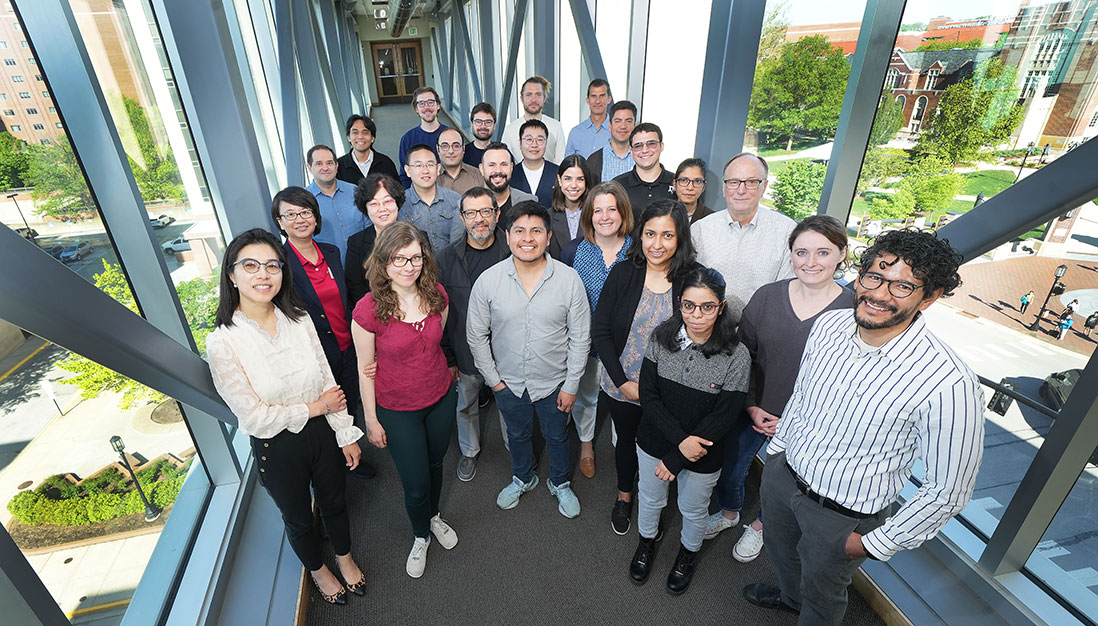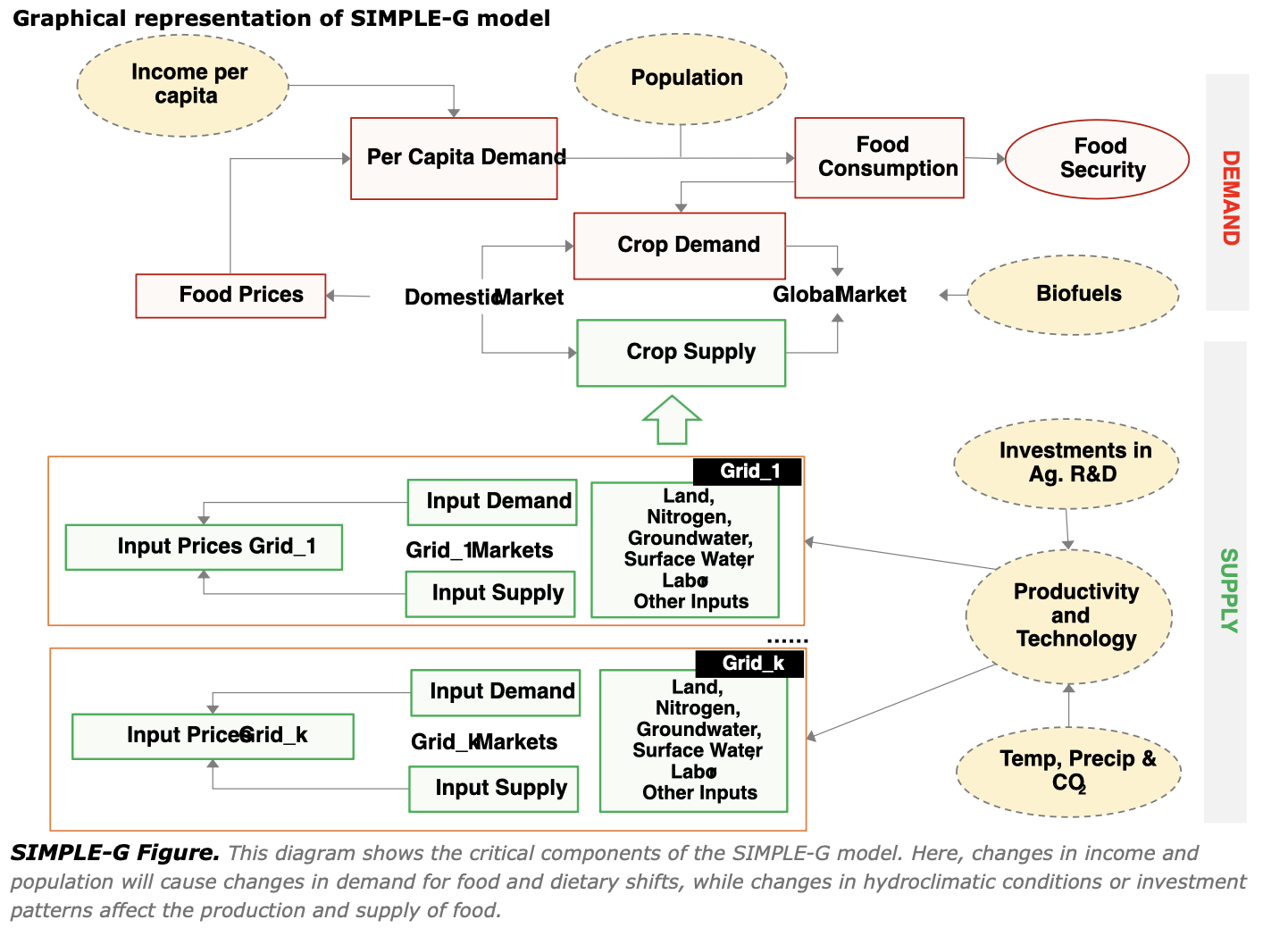MyGeoHub successfully hosts the 2024 SIMPLE-G Short Course
MyGeoHub, the geospatial science gateway designed to support geospatial modeling, data analysis, and visualization, has a lot to offer to the broad research and education communities. Through hosting groups, datasets, tools, training materials, and educational content, MyGeoHub has set out to become the preeminent online hub in the geospatial science fields. One of its innovative features is the ability to host and teach full online courses. Recently, MyGeoHub successfully hosted the 2024 Multi-Scale Analysis of Sustainability SIMPLE-G Short Course.
Dr. Jing Liu, Research  Economist/GLASSNET Science Coordinator in the Department of Agricultural Economics at Purdue University, began organizing and teaching the SIMPLE-G Short Course in 2019. The course has had three successful iterations—in 2019, 2022, and just recently, in April of 2024—all supported by MyGeoHub. Liu’s goal with the course is to not only teach users how best to utilize an agricultural economic modeling tool known as SIMPLE-G, but also to bring together economists and physical scientists in order to promote long-term collaboration between the groups. To that end, Liu designed the SIMPLE-G Short Course to provide participants with comprehensive training in the equilibrium modeling tools for economics as well as interdisciplinary analysis of sustainability issues across local, national, and global scales. The course has proven to be tremendously successful throughout the years. This year’s cohort had 18 participants from Asia, Latin America, Europe, and the US. These participants completed four weeks of online coursework, hosted entirely on MyGeoHub, before gathering in-person at Purdue University for a final week of instruction.
Economist/GLASSNET Science Coordinator in the Department of Agricultural Economics at Purdue University, began organizing and teaching the SIMPLE-G Short Course in 2019. The course has had three successful iterations—in 2019, 2022, and just recently, in April of 2024—all supported by MyGeoHub. Liu’s goal with the course is to not only teach users how best to utilize an agricultural economic modeling tool known as SIMPLE-G, but also to bring together economists and physical scientists in order to promote long-term collaboration between the groups. To that end, Liu designed the SIMPLE-G Short Course to provide participants with comprehensive training in the equilibrium modeling tools for economics as well as interdisciplinary analysis of sustainability issues across local, national, and global scales. The course has proven to be tremendously successful throughout the years. This year’s cohort had 18 participants from Asia, Latin America, Europe, and the US. These participants completed four weeks of online coursework, hosted entirely on MyGeoHub, before gathering in-person at Purdue University for a final week of instruction.
The main focus of the short course is on teaching researchers the ins and outs of the SIMPLE-G model and its framework. The Simplified International Model of agricultural Prices, Land use, and the Environment (SIMPLE) is a global economic model of food and the environment. SIMPLE-G is the gridded version of this model which offers a detailed, spatially resolved view of land, water, labor, and agricultural production. The grid cell resolution of the model is 5 arcminutes, or roughly 8 kilometer by 8 kilometer segments, and covers the entirety of the Continental United States. The model itself is extraordinarily comprehensive, capturing information about agricultural production, including land use (crops planted, irrigated vs. rain-fed, etc.) and non-land use (labor cost, machinery costs, etc.) inputs. The development of SIMPLE-G was driven by the need to better connect economic modeling to the biophysical world, relying on precise, local data instead of data at the state or national levels. When you account for differences on a local level, you can obtain far more accurate agroeconomic models. The whole idea is to capture and represent Global-to-Local-to-Global (GLG) feedback and connections. GLG analysis is a recent concept in sustainability research that recognizes that global and local systems are intrinsically connected. This is the theme of GLASSNET, an NSF-funded project aimed at building a network of networks working on sustainability challenges. Any model that does not adequately capture the global drivers of local stressors (e.g. climate change), spillover effects (e.g. a location-specific policy indirectly affects other regions through markets and prices), and key mesoscale processes (e.g. labor market functioning) will ultimately be misleading. SIMPLE-G was designed to account for these types of interactions while simultaneously considering the behavioral response of farmers to policies.
“The local-to-global effects in agricultural economic modeling are often overlooked,” says Liu. “Most biophysical models don’t have the ability to include behavioral response feedback into the system, which is incredibly important to the outcome. For example, say that fertilizer prices increase. Each individual farmer will see the price increase and react accordingly. Many of them choose to reduce fertilizer applications. This leads to a lower fertilizer demand, which leads to a lower fertilizer price, which then encourages more applications elsewhere, affecting the entire food production industry. Most agronomists will assume a fixed fertilizer price because their models cannot capture these interactions, and that can lead to incorrect predictions. With the SIMPLE-G model, all of this can be taken into consideration.”
SIMPLE-G is an instrumental  tool in conducting interdisciplinary modeling and research. But, as with any tool, its value is dependent upon knowing how to use it, which is why the SIMPLE-G short course is so important. In order to develop the best course possible, Liu chose to host the course on MyGeoHub. MyGeoHub is ideal for supporting these types of training and education courses thanks to its advanced cyberinfrastructure (CI) capabilities. In fact, MyGeoHub’s cyberinfrastructure enabled the development of an online SIMPLE-G modeling tool (hosted on MyGeoHub) which has been used in teaching and training in addition to research.
tool in conducting interdisciplinary modeling and research. But, as with any tool, its value is dependent upon knowing how to use it, which is why the SIMPLE-G short course is so important. In order to develop the best course possible, Liu chose to host the course on MyGeoHub. MyGeoHub is ideal for supporting these types of training and education courses thanks to its advanced cyberinfrastructure (CI) capabilities. In fact, MyGeoHub’s cyberinfrastructure enabled the development of an online SIMPLE-G modeling tool (hosted on MyGeoHub) which has been used in teaching and training in addition to research.
On MyGeoHub, instructors can easily set up and launch interactive courses. Jupyter notebooks can be hosted within learning modules so that students can develop and test code directly on the MyGeoHub website. And as long as the instructor already has their course materials, setting up different learning modules is easy and takes little time. Once the course has been developed, instructors can monitor how many students are participating, as well as individual progress on each module. Course announcements can be made and posted, and discussion boards can be created to support group dialogue between everyone in the course. Liu uses all of these capabilities during the short course. Each week, she has the students complete a “live” assignment, due on Friday, which is then graded over the weekend so that feedback can be given on Monday. Even during the final week of the course, which takes place in-person, the course materials and hands-on lab work are hosted on MyGeoHub. Liu sets up three or four separate projects for the course. Students pick one of the projects to work on throughout the week. Each project will have four to five students, and they all work together to modify the existing model, run the simulations, and analyze their results.
“The SIMPLE-G Short Course is hosted on MyGeoHub, which we love very much,” says Liu. “Not only is it easy for instructors, but it is easy for students as well. After this year’s course, I sent out a post-course survey and received a lot of positive feedback regarding the use of MyGeoHub. The students felt it was easy to access and sign up [accounts for MyGeoHub are free], and that the materials were very well organized and easy to follow.”
Each year that the SIMPLE-G Short Course is hosted, the course materials evolve to represent the changing needs of the research community. Liu intends for the next course to take place in 2026. For those who don’t want to wait until then to learn about SIMPLE-G and how to utilize it, more exciting news is on the horizon. The team that developed SIMPLE-G, including Liu, is publishing an instructional book, titled “SIMPLE-G: A Gridded Economic Approach to Analysis of Sustainability of the Earth’s Land and Water Resources.” The book is anticipated to be released by Springer Publishing in August of 2024. It will introduce SIMPLE-G with a transparent, grid-level perspective, that dissects the interconnected systems of land use, production, and trade across the globe. Through compelling applications, the SIMPLE-G book will illustrate how to analyze policy options, assess future scenarios, and chart a path towards a resilient and sustainable agricultural future. This book will provide a framework for evaluating the intricate links between human needs, environmental demands, and a sustainable environment for all living beings. Once this open-access book is published, readers will also be provided access to the model codes with follow-along instructions that can be used on the MyGeoHub website.
To learn more about SIMPLE-G and see recent examples of research it has enabled, please visit: https://www.gtap.agecon.purdue.edu/SIMPLE-G/
Access to the SIMPLE-G US Jupyter Notebook can be found here: https://mygeohub.org/resources/simplegus
To learn more about Global-to-Local-to-Global sustainability analysis, please visit: https://iopscience.iop.org/article/10.1088/1748-9326/acf8da
More information about MyGeoHub can be found here: https://mygeohub.org/
The SIMPLE-G Short Course was made possible by the collaborative work of the GLG lab, led by Professor Tom Hertel.
The NSF funds multiple agriculture and cyberinfrastructure projects. Special acknowledgments for projects discussed in this article are for NSF AccelNet (Grant # OISE-2020635) and NSF INFEWS: U.S.-China (Grant # BET-1805808).
Written by: Jonathan Poole, poole43@purdue.edu
